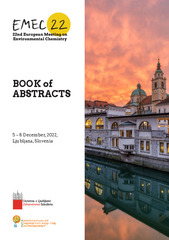Prikaz osnovnih podataka o dokumentu
The removal of thiophanate-methyl using novely synthesized catalysts CeO2-P25 under simulated sunlight: Structural characterisation and photocatalytic activity
| dc.contributor | Bavcon Kralj, Mojca | |
| dc.contributor | Trebše, Polonca | |
| dc.contributor | Prosenc, Franja | |
| dc.contributor | Šunta, Urška | |
| dc.contributor | Čižmek, Lara | |
| dc.creator | Jovanović, Aleksandar | |
| dc.creator | Stevanović, Marija | |
| dc.creator | Bugarčić, Mladen | |
| dc.creator | Sokić, Miroslav | |
| dc.creator | Tomašević, Anđelka | |
| dc.creator | Marinković, Aleksandar | |
| dc.date.accessioned | 2023-11-07T12:24:36Z | |
| dc.date.available | 2023-11-07T12:24:36Z | |
| dc.date.issued | 2022 | |
| dc.identifier.isbn | 978-961-297-034-5 | |
| dc.identifier.uri | https://ritnms.itnms.ac.rs/handle/123456789/1025 | |
| dc.description.abstract | Environmental pollution by wastewater represents one of the greatest challenges nowadays. The solution for this issue requires implementation of novel treatment methods. Therefore, enhanced techniques so-called Advanced oxidation processes (AOPs) are gaining increasing attention. Photocatalysis is a process based on the use of different types of irradiations on a pollutants adhered on a catalyst, driven by formation of radicals and oxidative species on the catalyst surface. Modern agricultural practice relies on use of different classes of pesticides, and to its, often, uncontrolled and excessive use. It leads to their widespread in the environment, with frequent detection in waterbodies and soil. Thiophanatemethyl (TPM) is benzimidazole fungicide, used in control of diverse groups of phytopatogenic fungus [1]. Specifically efficient and economically viable catalysts are TiO2-based. Multiphase catalysts showed better results in the degradation of various pollutants, so TiO2 P25 (Degussa) was used as a material that boosts photocatalytic decomposition. In order to advance and fasten the reaction, the surface of TiO2 P25 was decorated with cerium (IV) oxide [2]. Surface and photochemical properties of newly obtained material are characterised by HR - TEM, HAADF - STEM; FTIR and UV - DRS methods. In this study, the photocatalytic degradation of thiophanate-methyl (TPM) in the presence of CeO2 - P25 was investigated. Different experimental conditions were varied, such as the concentration of the pesticide solution and the mass of the catalyst. Monitoring of the pesticide concentration in the reaction system was based on the decrease in absorbance using a Shimadzu 1800 UV spectrophotometer. Results of textural and structural analyses prove decoration of P25 surface with particles of cerium (IV) oxide uniformly. Synthesised nanocatalyst CeO2-P25 has lower band gap energy (2.90 eV) then P25 (3.30 eV). The optimal experimental conditions were obtained using 0.07 g/L of CeO2-P25 and 5 mg/L of TPM solution. Degradation reaction rate follows pseudo-first order law. Complete degradation was performed after 120 min. In experiments with TiO2 P25 catalyst (Degussa) degradation time was 240 min. Hence, it can be concluded that the synthesized CeO2-P25 catalyst has better performance. | sr |
| dc.language.iso | en | sr |
| dc.publisher | Ljubljana : University of Ljubljana Press | sr |
| dc.relation | info:eu-repo/grantAgreement/MESTD/inst-2020/200023/RS// | sr |
| dc.relation | info:eu-repo/grantAgreement/MESTD/inst-2020/200214/RS// | sr |
| dc.relation | info:eu-repo/grantAgreement/MESTD/inst-2020/200135/RS// | sr |
| dc.rights | openAccess | sr |
| dc.source | 22nd European Meeting on Environmental Chemistry EMEC22 | sr |
| dc.title | The removal of thiophanate-methyl using novely synthesized catalysts CeO2-P25 under simulated sunlight: Structural characterisation and photocatalytic activity | sr |
| dc.type | conferenceObject | sr |
| dc.rights.license | ARR | sr |
| dc.citation.epage | 68 | |
| dc.citation.spage | 68 | |
| dc.identifier.doi | 10.55295/9789612970352 | |
| dc.identifier.fulltext | http://ritnms.itnms.ac.rs/bitstream/id/2259/bitstream_2259.pdf | |
| dc.type.version | publishedVersion | sr |

